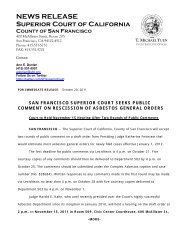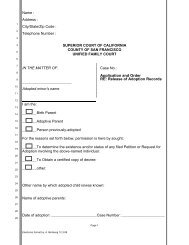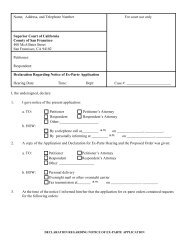Civil Grand Jury report - Superior Court of California
Civil Grand Jury report - Superior Court of California
Civil Grand Jury report - Superior Court of California
- No tags were found...
You also want an ePaper? Increase the reach of your titles
YUMPU automatically turns print PDFs into web optimized ePapers that Google loves.
City and County <strong>of</strong> San Francisco2012-2013 <strong>Civil</strong> <strong>Grand</strong> <strong>Jury</strong>violations addressed by these divisions are: additions <strong>of</strong> bathrooms, kitchens, and in-lawunits; abandoned and dilapidated buildings; leaking sewer lines; improper wiring thatcreates a fire hazard; and non-compliant water heaters.The steps in the building codes enforcement process in these divisions are:• After inspection and verification <strong>of</strong> a code violation, the inspector issues a first NOVwith a specified time frame for obtaining permits and correcting the violation.• After a re-inspection, if all items are not corrected, the inspector issues a second NOVthat provides additional time for corrective action. (Re-inspection is scheduled at thediscretion <strong>of</strong> the inspector.)• When the second NOV does not achieve compliance, the matter is referred to theCode Enforcement Section (CES) <strong>of</strong> Inspection Services. The CES decides when toorder a Director’s Hearing and at that point the same steps are available as in housinginspection cases.The CES can issue its own NOVs, as well, as in the case <strong>of</strong> a vacant building that isconsidered a nuisance. When a property owner is in violation <strong>of</strong> a number <strong>of</strong> differentcodes, there may be NOVs issued concurrently by any combination <strong>of</strong> the Housing,Building, Plumbing, and Electrical Inspection and Code Enforcement divisions.iii. DBI Performance on Code EnforcementThe <strong>Jury</strong> attended a number <strong>of</strong> BIC meetings that included discussion <strong>of</strong> some 6,000pending, unresolved NOVs. We performed a statistical analysis <strong>of</strong> all NOVs issued byDBI over a two-year period. The goal <strong>of</strong> the analysis was to calculate the number <strong>of</strong>NOVs issued by each DBI division and the amount <strong>of</strong> time required by each division toresolve a NOV. The DBI gave the <strong>Jury</strong> a spreadsheet download <strong>of</strong> the 8,875 NOVrecords for FY 2008-09 and FY 2009-10, providing a data snapshot <strong>of</strong> the status <strong>of</strong> thoseNOVs as <strong>of</strong> April 30, 2013.During the two <strong>report</strong>ed time periods:• The DBI issued 8,875 NOVs. Of these, HIS issued 5,992 (68 percent) and 527(nine percent) remain open.• The DBI conducted 766 Director’s Hearings for all divisions. HIS initiated 634(83 percent) <strong>of</strong> these. After going to Director’s Hearings, 238 (38 percent) <strong>of</strong> HISNOVs remain open. Thus, the Director’s Hearing process is 62 percent effectivein abating or closing out HIS NOVs.• The Building, Electrical, and Plumbing Code Enforcement divisions issued 2,848(32 percent) <strong>of</strong> the DBI NOVs. The Building Inspection Division accounts for 70percent. Eighteen percent remained open as <strong>of</strong> May 2013. This is twice the rate <strong>of</strong>open NOVs in HIS.Building a Better Future at the Department <strong>of</strong> Building Inspection18
















